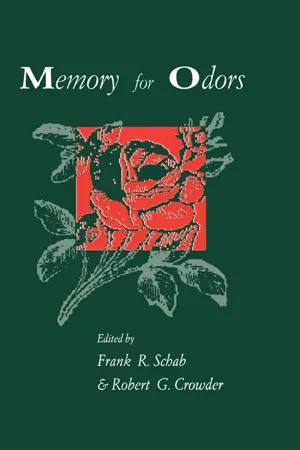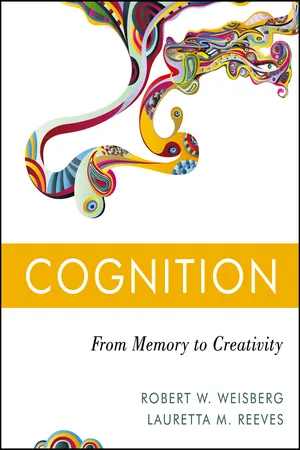Languages & Linguistics
Olfactory Imagery
Olfactory imagery refers to the use of descriptive language to evoke the sense of smell in literature or communication. It involves creating vivid and sensory descriptions related to scents and odors to engage the reader's olfactory senses. This type of imagery can enhance the overall sensory experience of a piece of writing, making it more immersive and evocative.
Written by Perlego with AI-assistance
Related key terms
4 Key excerpts on "Olfactory Imagery"
- eBook - ePub
- Frank R. Schab, Robert G. Crowder(Authors)
- 2014(Publication Date)
- Psychology Press(Publisher)
But experience is not evidence. It is where the need for psychological analysis steps in; it poses the question of whether and how Olfactory Imagery may be brought into the laboratory, uncontaminated by those external contributions which are so inevitable in everyday experience. That is the mandate of this chapter. Although many of us are confident about our ability to image odors (Brower, 1947; Lindauer, 1969), our introspections on this may ultimately prove fallacious, just as average people’s confidence in their ability to identify objects by smell alone has been shown to be unrealistically high (see de Wijk, Schab, & Cain, chapter 3, this volume). One reason for the scarcity of experimental data on odor imagery is the difficulty of designing sensitive and appropriate laboratory techniques for studying the phenomenon. Looking to the literature on visual imagery turns out to be of little help, because some of the standard paradigms for studying visual imagery make little or no sense when translated to the olfactory domain. For example, the processing of an olfactory image, in the tradition of Shepard and Metzler’s (1971) demonstration of mental rotation, seems at this point to be an elusive goal, as does an olfactory adaptation of the scanning of images in the manner of Kosslyn (1980) and his associates. Size scaling (Bundesen & Larson, 1975; Sekular & Nash, 1972) appears to offer no approach, either. Olfactory responses are notoriously sluggish, so we do not naturally think of reaction-time methods like that of Posner, Boies, Eichelman and Taylor (1969) from the start, although slow processing does not in principle disqualify response timing as an index - eBook - ePub
- E. Bruce Goldstein(Author)
- 2009(Publication Date)
- SAGE Publications, Inc(Publisher)
Journal of Experimental Psychology: Learning, Memory & Cognition, 16 , 656–664.Morrot, G., Brochet, F., & Dubourdieu, D. (2001). The color of odors. Brain & Language, 79 , 309–320.Schifferstein, H. (1997). Perceptual and imaginary mixtures in chemosensation. Journal of Experimental Psychology: Human Perception & Performance, 23 , 278–288.Stevenson, R., & Case, T. (2005). Olfactory Imagery: A review. Psychonomic Bulletin and Review, 12 , 244–264.OLFACTORY LOCALIZATIONAnimals must find food, find mates, and avoid potential dangers, such as predators, to survive and perpetuate their species. To achieve these goals, the vast majority of animals use their senses to navigate though their environments. Myriad organisms, from bacteria to humans, sense ambient chemicals to help them navigate. Olfaction (smell), the modality that senses volatile chemicals, is especially important for many organisms.An odorous molecule contains no spatial information. However, as molecules are deposited on surfaces or spread out in air or water, their pattern of deposition over space and time can provide rich information regarding the location of the source that emitted them. The exact information available, and how this information is used, depends on the species and the medium in which the odor is found (for example, a scent trail on the ground versus airborne molecules traveling downwind from a source). In addition, it is becoming increasingly clear that, although animals can locate objects purely through olfactory cues in some situations, animals usually navigate by integrating olfactory information with information from the other senses. Some topics discussed in this entry are: tracking odor trails, the spatial information present in odors dispersed in fluid, tracking using signals from chemicals dispersed in fluid, the integration of information from odor and other senses, and whether humans can track using odors. - eBook - ePub
Cognition
From Memory to Creativity
- Robert W. Weisberg, Lauretta M. Reeves(Authors)
- 2013(Publication Date)
- Wiley(Publisher)
seems like hearing; that is an example of auditory imagery. Similarly, I can imagine the smell of freshly cut garlic (olfactory, or smell, imagery), the taste of pea soup (gustatory, or taste, imagery), the sight of a basketball player leaping through the air (visual imagery), and the feel of the cold ocean water covering my feet at the seashore (tactile, or haptic, imagery). While those examples of imagery are based on memories of particular experiences that I have had, I can also imagine things I have never experienced, such as my mother playing tennis, or a pink elephant. In each case, whether the image is recalled or created, it seems to retain some of the properties of a perceptual experience: A visual image of an evergreen tree retains the tree's familiar shape, color, and a sense of depth (assuming one does not image a photograph of the tree); our auditory image has the same melody as the original tune we heard.One critically important aspect of imagery from the perspective of cognitive science is that imagery seems to be an inherently subjective phenomenon: Our images occur inside us, making it difficult to accurately ascertain what another person is imaging. That subjectivity would seem to make it impossible to study imagery using the objective methods of science. However, one of the truly revolutionary aspects of modern cognitive science is that researchers have developed methods that have made the study of imagery a legitimate topic for scientific investigation. Thus, in addition to its inherent interest, the research to be discussed in this chapter is also important because it is a case study in how one can apply scientific methods to the analysis of cognitive phenomena that seem to be inherently subjective. That development is what makes the study of imagery so fascinating, and it is what we hope to convey in this chapter. - eBook - ePub
Wine Tasting
A Professional Handbook
- Ronald S. Jackson(Author)
- 2016(Publication Date)
- Academic Press(Publisher)
Thus, odor terms typically are concrete, referring to a specific or group of objects or experiences, and not to the olfactory perception itself. Usually, the more significant the event, the more intense and stable the memory. Engen (1987) views this memory pattern as equivalent to how young children associate words, categorizing objects and events functionally, rather than conceptually. For example, a hat is something a person might wear on their head, rather than a representative of an article of clothing. This may partially clarify why it is so difficult to use unfamiliar terms (e.g., chemical names) for familiar odors. The difficulty of correctly naming odors may also arise from the localization of language and concepts in different hemispheres of the brain, typically left versus right, respectively (Herz et al., 1999). People also have difficulty envisaging odor sensations, in contrast to the ease of conjuring up visual and auditory memories. Verbal or contextual clues improve identification (de Wijk and Cain, 1994a), in the same way that suggestion can influence what can be perceived in cloud formations. Pronouncing the name of a cultivar or an odor often induces its apparent detection, even in its absence. Suggestion seems to organize (or reorganize) odor perception in a manner similar to the way hints reshapes vision or memory (Murphy, 1995). In addition, experience can induce the perception of objects, for example, in a painting, that are not actually there, but could be considered appropriate to be there (Livingstone, 2002). Although supplying verbal, visual, or contextual clues often facilitates odor identification, odors learned in the absence of visual clues (e.g., the smell of toast or frying bacon) are easily recognized by odor alone. Odor terms derived from personal experience are generally more easily recalled than those generated by others (Lehrner et al., 1999a)
Index pages curate the most relevant extracts from our library of academic textbooks. They’ve been created using an in-house natural language model (NLM), each adding context and meaning to key research topics.



